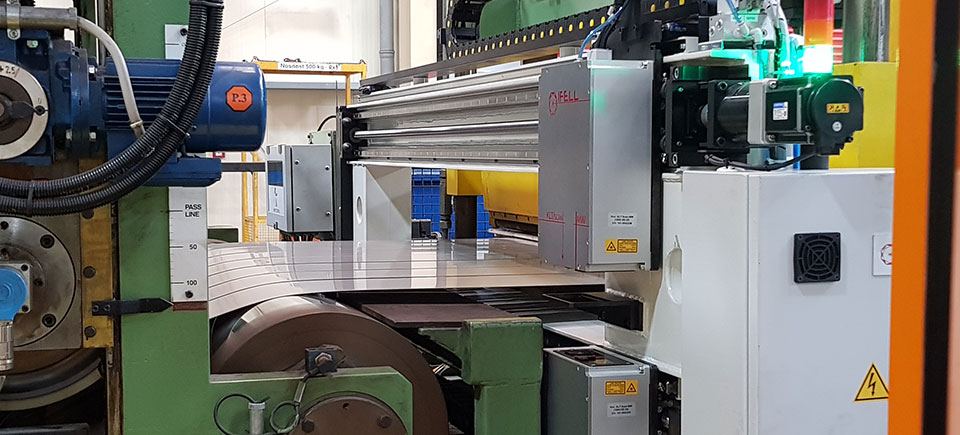THICKNESS GAUGES.
Complete range of gauges: single point, multipoint and scanning
for METAL STRIPS and FLEXIBLE MATERIALS.
Heavy-duty mechanical frames for harsh industrial environments with high-level protection for optoelectronic components.
Automatic calibration systems on certified samples.
Intuitive operator panel for real time display of measurements in graphic and digital form.
Automatic data report shared on local network.
Data and signals exchange on any type of fieldbus for automatic processing lines.

TYPICAL APPLICATIONS FOR
METAL STRIPS
Slitting lines
Cut to length lines
Levelling lines
Galvanizing / pickling / finishing lines

KLT SINGLE POINT thickness gauges
To measure one point near the edge or up to centreline.
Gauges can be installed on a fixed position or on a linear axis for manual or automatic movement from the parking position to measuring point.
The out of line parking position allows to safely insert the material before the positioning of the gauge at the measuring point.
The gauges throat depth has a range between 100 to 1100 mm, according to the selected model.

KLTn MULTIPOINT thickness gauges
To measure two or more points at the same time on the same material section.
Typical configurations can be with only two measuring points nearby the material edges or with a third centreline point.
In this case, the central point is always fixed and the external ones can be moved according to the material width change.
For application which needs a higher number of measuring points, it is suggested to also consider the KLT-scan models.


KLT-scan SCANNING thickness gauges (…and combined thickness&width gauges)
For continuous measurements of thickness profile along full material width. The measuring head automatically moves from one material side to the other side providing the thickness measurements at as many points as necessary in the specific application task. The measuring head is normally in a protected parking position, thus allowing the safe material insertion.
Standard gauges are available to process materials up to 2200 mm in width and up to 20 mm in thickness. For wider or thicker materials, contact IFELL technical service.
Two options are available, specially designed for slitting lines:
- the multistrip mode, that allows to scan the full material width and to display the individual measurements of each slitted strip both as operator interface and as separated control reports.
- the combined gauge KLT-scan-MW that allows to measure both thickness and width of prespaced strips, obtaining a double function in the same gauge.
HOW IT WORKS
KLT thickness gauges are based on the well known laser triangulation principle with two laser sensors mounted at the opposite sides of the target material. Each sensor measures the position of the relevant surface along its optical axis by means of a small laser beam observed through an optical system at a certain angle. The material thickness is calculated from the combination of the positions of the two material surfaces, given the distance between the two sensors (working distance). The measuring task is performed when both material surfaces are running inside the specified measuring range.
TYPICAL APPLICATIONS FOR
FLEXIBLE MATERIALS
Foam extrusion lines
Plastic film extrusion lines
Bituminous membrane production
Rubber and PVC calendering

HLTn MULTIPOINT thickness gauges
To measure one or more points at the same time on the same material section.
Gauges can be installed in fixed point(s) or with linear guide for positioning according to the material width change.

HLT-scan SCANNING thickness gauges
Continuous measurement of thickness profile along full material width.
The measuring head automatically moves from one material side to the other side providing the thickness measurements at as many points as necessary in the specific application task. The measuring head is normally in a protected parking position, thus allowing the safe material insertion.
HOW IT WORKS
HLT gauges are designed to measure the thickness of flexible materials by means of the optical projection of material surface when running over a reference roll inside the specified measuring range.
A light beam intercepts the roll edge and it is partially blocked by the material proportionally to its thickness. At the opposite side, at a certain working distance, a receiver measures the position of the free material surface with respect to the roll surface and it calculates the thickness of the material. For a correct measurement it is necessary that the material be in contact with the reference roll.





